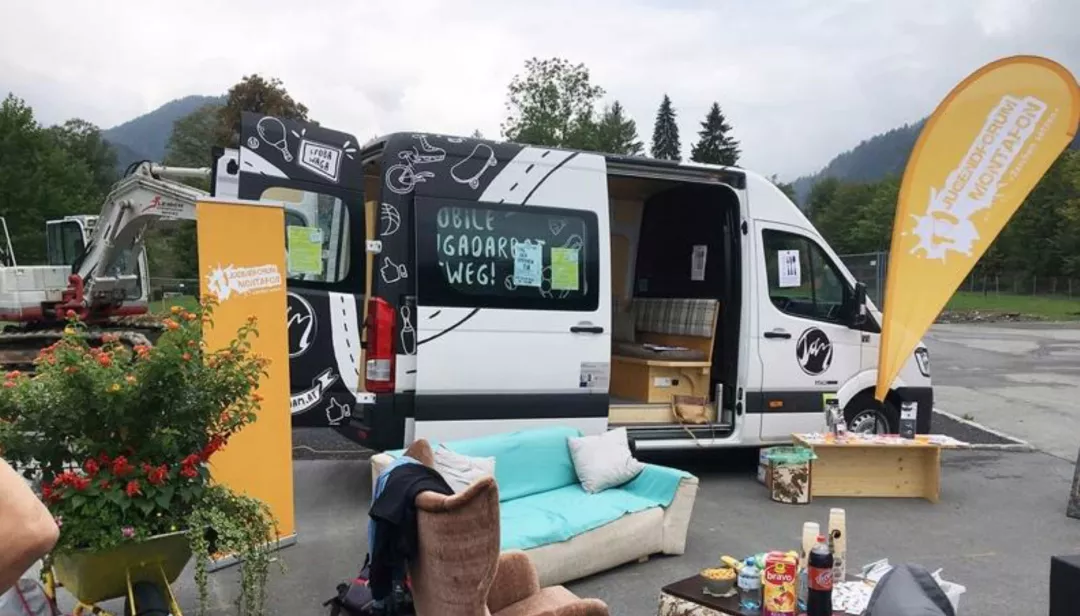General information
RDP Priority
- P6. Social inclusion and local development
RDP Focus Area
- 6B: Local development
RDP Measure
- M19: LEADER/CLLD
Summary
The Mobile Living Room has made mobile youth work possible in the Montafon region in western Austria. The project complements the Open Youth Work Montafon’s (JAM) existing offer of location-based youth interventions by responding to a general lack of youth services in the more remote areas of the region.
Results
The high number of visitors to the Mobile Living Room clearly show that the approach toward youth intervention in the region is effective.
Given what is widely understood about the benefits of this type of intervention, it can be assumed that the Mobile Living Room fulfils a preventive function, contributing to reducing violence and anti-social behaviour from this target age group.

Promoter
Offene Jugendarbeit Montafon – JAM
Funding
Total budget 79 342.00 (EUR)
EAFRD 38 084.00 (EUR)
National/Regional 9 521.00 (EUR)
Private 31 737.00 (EUR)
Sujets
Ressources
Documents
Context
Montafon is a 39 km long valley in the federal state of Vorarlberg in western Austria. The region has a population of about 16 000 inhabitants and, thanks to the opening of the Open Youth Work Montafon (JAM) youth centre in the municipality of Schruns, caters quite well to the needs of local young people. JAM offers a broad range of youth activities and special programmes for young adolescents up to the age of 16, as well as activities exclusively for girls.
However, the centre recognised that there were still individuals or groups of young people who, for various reasons, did not make use of their local youth centre. From a preventive point of view, a mobile youth programme was seen as a very important way for Montafon to expand its services to include hard-to-reach, delinquent or problematic young people.
Objectives
The aim of this project was to create a space for social learning in the fields of language, culture, political education, personal responsibility, and health. Fuelled by the enthusiasm and energy of JAM’s existing community, this project aimed to expand location-based youth work across Montafon and establish an interface between hard-to-reach communities and institutions and facilities supporting youth.
Activities
- Social Space Analysis – the analysis was conducted to find out where young people hung out and where this created problems that could be defused through professional intervention. It aimed to understand the barriers preventing some young people from making use of the services offered by JAM. Through discussions and interviews, a series of themes were identified for the Mobile Living Room to focus on. The Mobile Living Room’s communications campaign was launched, and the newly designed vehicle was unveiled. All of this contributed to building a positive image for the initiative.
- Establishment of the Steering Group "Youth in Montafon" and Youth Teams – members consisted of young people, politicians, and business and third sector representatives. The Mobile Living Room working agenda was developed through workshops, with topics such as sports, media, health, environment, and democracy identified. The Youth Teams fed into all aspects of the Mobile Living Room’s development by sharing their needs and expectations as well as working to support the development and evaluation of programmes for young people.
- Mobile Infrastructure – A suitable van was purchased and adapted to the needs and interests of the young people, the Steering Group and the youth workers. The exterior of the van was designed according to the ideas and suggestions of the young people.
- Action Plan for Mobile Youth Work – Based on the social analysis and in close cooperation with the Steering Group and the Youth Teams, an action plan was prepared to guide the mobile youth workers. The thematic focal points of the workplan were then adapted to the needs of different communities and, above all, according to the needs and interests of young people.
Main results
The high number of visitors to the Mobile Living Room clearly show that the approach toward youth intervention in the region is effective.
Through its social learning programme, the Mobile Living Room promotes personal development, resilience and civic engagement for young people, both on an individual as well as a collective level. As a preventive measure, this contributes to reducing violence and anti-social behaviour from this target age group.
Key lessons
While there are established ways to gauge the impact of social work interventions, such as youth programmes, it is not always realistic for teams to gather data and measure outcomes in this way alongside delivering a high-quality offer and building relationships with the local community. Most often, it is the subjective impression of the youth workers that becomes the measure of how well an intervention has worked.
